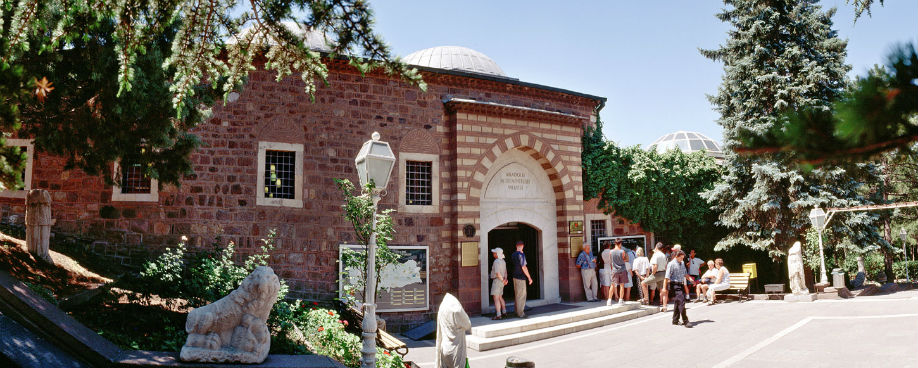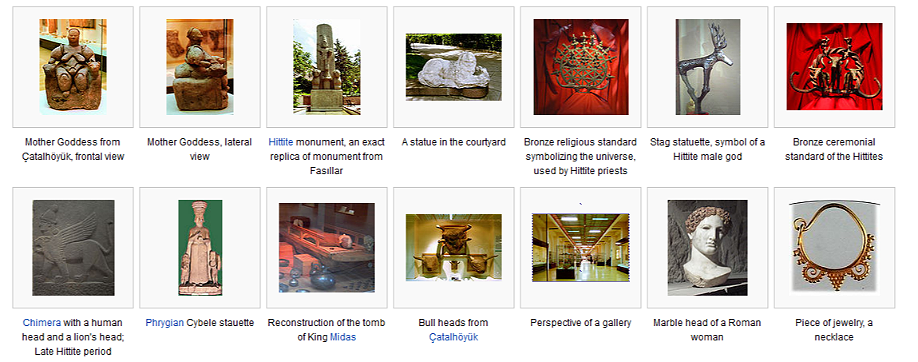The superb Museum of Anatolian Civilisations is the perfect introduction to the complex weave of Turkey’s ancient past, housing artefacts cherry-picked from just about every significant archaeological site in Anatolia.
The museum is housed in a beautifully restored 15th-century bedesten (covered market). The 10-domed central marketplace houses reliefs and statues, while the surrounding hall displays exhibits from the earlier Anatolian civilisations: Palaeolithic, Neolithic, Chalcolithic, Bronze Age, Assyrian, Hittite, Phrygian, Urartian and Lydian. The downstairs sections hold classical Greek and Roman artefacts and a display on Ankara’s history. Get there early to avoid the flood of tour groups and school parties.
The exhibits are chronologically arranged in a spiral: start at the Palaeolithic and Neolithic displays in the room to the right of the entrance, then continue in an anticlockwise direction, visiting the central room last.
Items from one of the most important Neolithic sites in the world Çatalhöyük, southeast of Konya – are displayed here. There’s a mock-up of the inside of a dwelling typical of those uncovered at the site, one of the most famous mother goddess sculptures unearthed from the excavations and wall paintings of hunting scenes.
Also on show are many finds from the Assyrian trading colony Kültepe, one of the world’s oldest and wealthiest bazaars. These include baked-clay tablets found at the site, which dates to the beginning of the 2nd millenium BC.
One of the striking Hittite figures of bulls and stags in the next room used to be the emblem of Ankara. The Hittites were known for their relief work, and some mighty slabs representing the best pieces found in the country, generally from around Hattuşa, are on display in the museum’s central room.
Most of the finds from the Phrygian capital Gordion, including incredible inlaid wooden furniture, are on display in the museum’s last rooms. The exhibits also include limestone blocks with still-indecipherable inscriptions resembling the Greek alphabet, and lion- and ram-head ritual vessels that show the high quality of Phrygian metalwork.
Urartian artifacts are also on display here. Spurred by rich metal deposits, the Urartians were Anatolia’s foremost metalworkers, as the knives, horse-bit, votive plates and shields on display demonstrate. There are also terracotta figures of gods in human form, some revealing their divine powers by growing scorpion tails, and neo-Hittite artefacts.
Downstairs, classical-period finds and regional history displays provide a local picture. Excavations have unearthed a Roman road near the Column of Julian, and Ankara has its own ‘missing link’, the 9.8-million-year-old Ankarapithecus (a 30kg, fruit-eating primate).




The museum travels through time, showing us how Turkey evolved through the centuries. A wonderful travel in time!
This museum has many artifacts from times long before the Hittites and up to times of the Hittites, Phrygians, and other civilizations. Some really amazing items here.
Not the biggest museum I have ever seen, but has a pretty decent collection. I loved how the potteries evolved.
The museum is fascinating.
At the entrance you can choose an audio tour that will guide you through your entire museum. As important fact of my visit was the first place on Ankara where can find a guide who spoke Spanish and English.
The museum has extraordinary pieces and is divided into different periods of history.
Whilst visiting this outstanding museum we also encountered many Turkish school children having an important history lesson. The question "what's your name and where do you come from?" was constantly in our ears. Brilliant!
And what a remarkably interesting museum. The wealth of Artefacts and the style of exhibiting these items onsite is truly astonishing. All exhibits are described in…
This museum was under renovation when we visited. Many exhibition rooms were closed. The museum does not protect their antique exhibits very well. People were touching and feeling them all the time. The engraving and markings on the exhibits will be gone very soon.
Not an easy thing to say but it is true. A stunning collection and very well laid out.
This museum has an incredible collection from Anatolian and Antique civilizations. The museum is built in an old architecture which is really incredible !
Here you can see where our civilisation started. Very well showed with good explications. You have to be lucky that there are not to manu schoolchilderen are around. It was pity that an important part of the museum was closed.
There was some remodeling being carried out so that was a bit distracting, but the quality of the exhibits was amazing. It was fascinating to get a feeling for the depth and breadth of the history of Anatolia.